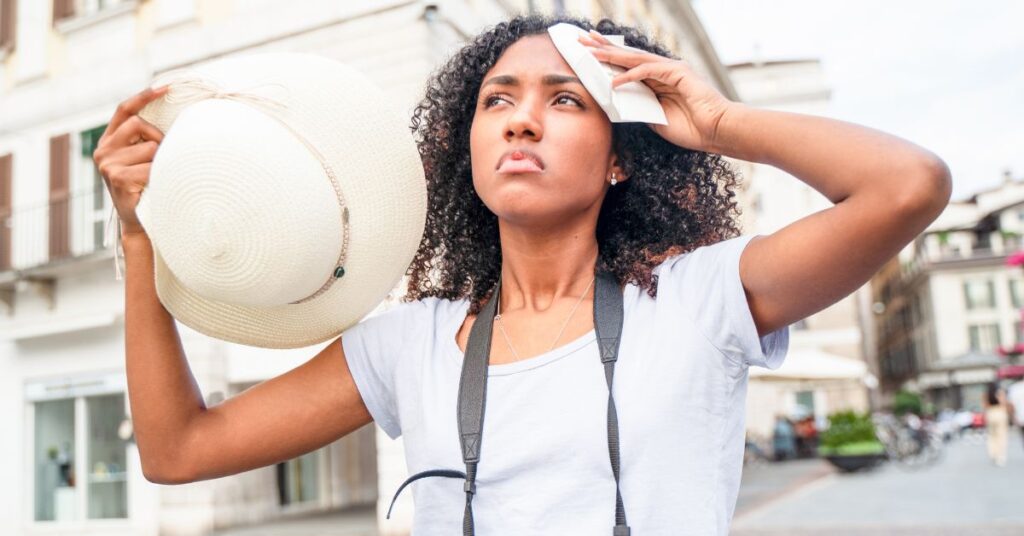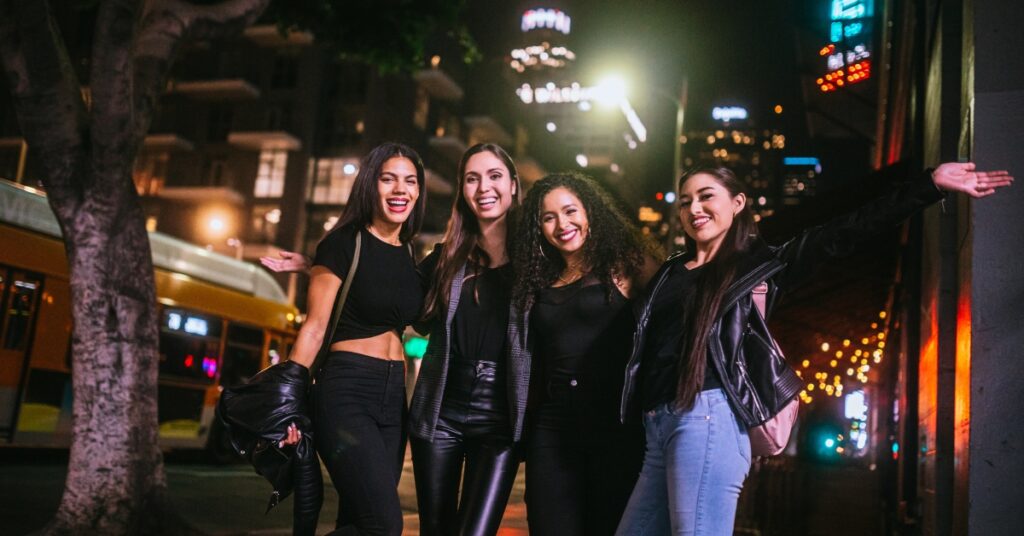Last Updated on January 10, 2025 by Eric Livingston
Live in Colombia with Caution
- Live in Colombia with Caution
- Want to Live in Colombia?
- Lots of Venezuelans Have Fled to Colombia
- Colombia Has Diverse Climates
- Brief History of Colombia
- The Spanish Begin Colonization of Colombia
- Simón Bolívar and Francisco de Paula Santander Head Up a Rebel Army to Fight the Spanish
- La Gran Colombia is Born
- La Gran Colombia was Comprised of Present Day Colombia, Ecuador, Panama and Venezuela
- La Gran Colombia Disbands After 11 Years
- Ecuador Follows Venezuela's Lead and Frees Itself from La Gran Colombia
- Panama, with Backing of the United States, Separates from La Gran Colombia
- Colombian Food
- Cosmetic Surgery and Medial Tourism in Colombia
- Major Cities to Live in Colombia
- Bogotá, Colombia
- The Best Places to Live in Bogotá, Colombia
- Cultural and Tourist Places in Bogotá, Colombia
- Cartagena de Indias, Colombia
- The Best Places to Live in Cartagena
- Become Familiar with the Different Strata Classifications in Cartagena
- Use Common Sense Security Measures When Visiting Cartagena
- Common Sense Security Tips for Colombia (or Anywhere)
- Use Common Sense Security Measures When Visiting Cartagena
- Beaches Near Cartagena
- Playa Blanca on Isla Baru
- Playa Bonita on Isla Grande
- Other Lesser-Known Beach Destinations Near Cartagena
- Castillo San Felipe de Barajas
- Castillo San Felipe de Barajas
- Cali, Colombia
- The Best Places to Live in Cali
- Cali Tourist and Cultural Places
- Medellín
- Climate in Medellín
- The Best Places to Live in Medellín
- Medellín as a Tourist Attraction
- Guatapé, Antioquia
- Other Notable Cities or Towns in Colombia
- Visas in Colombia
- Driver's Licenses and Importation of Vehicles for Foreigners in Colombia
- Properties in Colombia
- Get the True Market Value in Colombia and Don't Overpay
- Money Used to Buy Property is Registered through Banco de la República
- Make Sure Property and Valuation Taxes are Paid
- Hire a Notary Public to Ensure the Deed "La Escritura" is Free of Encumbrances
- A "Notario" is a Highly Regarded Designation Unlike the United States
- Transaction Costs for Purchasing a Home in Colombia
- Property Tax in Colombia
- Income Taxes in Colombia
- Cost of Living in Colombia
- Salaries in Colombia
- Banking in Colombia
- Permission to Carry Firearms in Colombia
Want to Live in Colombia?
Do you want to live in Colombia? Colombia is a multicultural, democratic country with diversified economic development. It has 32 departamentos and the capital district of Bogotá. Each state is referred to as departamento in Colombia and not estado like in Mexico or provincia like in Ecuador. It has 49.07 million inhabitants (2017), which make it the twenty-eighth most populated country in the world. It comprises the second highest number of native Spanish speakers in the world after Mexico just ahead of Spain.
Colombia is Ethnically Diverse
Colombia has an ethnic diversity among whites, blacks, mestizos and dozens of indigenous groups. Colombians tend to have a warm, welcoming way about them. Colombia is the second most biodiverse country in the world after Brazil (Spanish).
Colombia Is Now a Tourist Attraction
There is no precise figure for the number of tourists that visit Colombia each year because of the massive migration from its neighboring country Venezuela, due to its current political and social crisis. However, according to various media outlets such as El Espectador (Spanish), the number of visitors who arrived in Colombia in 2018 was 4.2 million, making it the largest number of visitors ever in one year. In July of 2019 Colombia achieved another record as it was recognized as the Best Destination in South America by the World Travel Awards (Spanish), an organization known as “the Oscars of Tourism”. Colombia has had astonishing economic development in recent years, leaving behind images of narcotic trafficking and guerilla warfare.
Lots of Venezuelans Have Fled to Colombia
While no country is perfect and Colombia is no exception, it has become a country where one can establish a quiet life in the countryside, enjoy its beautiful climate, or reside in one of its bustling cities that offer modern conveniences along with both typical and international cuisine. Most of the immigration in Colombia comes from Venezuela with 35.50%, the United States with 14.35% and Ecuador with 10.84%. Due to the diaspora in Venezuela because of its governments economic collapse under President Nicolas Maduro, the precise number of Venezuelan migrants is hard to determine as many simply crossed the border illegally before any type of systematic control was put in place. Some Venezuelans choose to venture further south to Ecuador and even further, Peru.
Colombia Has Diverse Climates
One of the variables that determine where one may want to live in Colombia are what type of climate they desire. I believe this is first and foremost in deciding where to reside for expats or even long-term digital nomads. If someone hates the heat, they shouldn’t even consider Cartagena. The Walled City is beautiful and well worth visiting and perhaps living. However, if hot weather isn’t one’s thing, then they should look elsewhere at higher elevations.
To Live in Colombia in an Expat Community or Not
One should also decide whether or not they want to live in an expat community. Some do, some don’t. There is no right or wrong answer; it just depends on the individual. Cost of living, entertainment options, hospitals, infrastructure, and overall safety are other common concerns to think of. Each city differs.
Brief History of Colombia
In 1499 the first Spanish expedition that arrived on the shores of present-day Colombia was initiated by Alonso de Ojeda, Juan de la Cosa and Américo Vespucio. Upon their arrival they found a dispersed indigenous population. The diversity of languages, customs, religions and geographical position became a disadvantage for the natives to face the invaders.
The Spanish Begin Colonization of Colombia
In 1509, the Spanish colonization process began, sprouting populations in the Urabá and Darién regions. Its first settlements did not work. However, the city of Santa Marta was founded in 1525 by Rodrigo de Bastidas. Santa Marta is the oldest still-inhabited city founded by Spaniards in Colombia. On August 6, 1538, Gonzalo Jiménez de Quesada defeated the Chibcha culture, and found the city of Santa Fe de Bogotá and naming it the Nuevo Reino de Granada. The New Kingdom of Granada was governed by the Royal Audience of Santa Fe de Bogotá, but important decisions for the Colony were taken from Spain by the Council of the Indies.
Simón Bolívar and Francisco de Paula Santander Head Up a Rebel Army to Fight the Spanish
In 1819 a rebel army recruited and commanded by General Simón Bolívar and General Francisco de Paula Santander fought Spanish General José María Barreiro and his Spanish royal army and won the Battle of Bocayá on August 7, 1819. It was a defining moment in history, marking a definitive defeat of the Spanish royal army and the beginning of the end for any remaining Realistas and Spanish rule.
La Gran Colombia is Born
The territory was renamed La Gran Colombia in honor of the navigator Christopher Columbus, although many historians believe he never stepped foot in present day Colombia. Most historians believe that Alonso de Ojeda, another Spanish navigator who previously sailed with Columbus, was the first European to step foot in present day Colombia at Bahia de Calamar, in present-day Cartagena. Ojeda went on to briefly explore the Sierra Nevada of Santa Marta. In any event, La Gran Colombia was adopted in 1819, by the Angostura Congress.
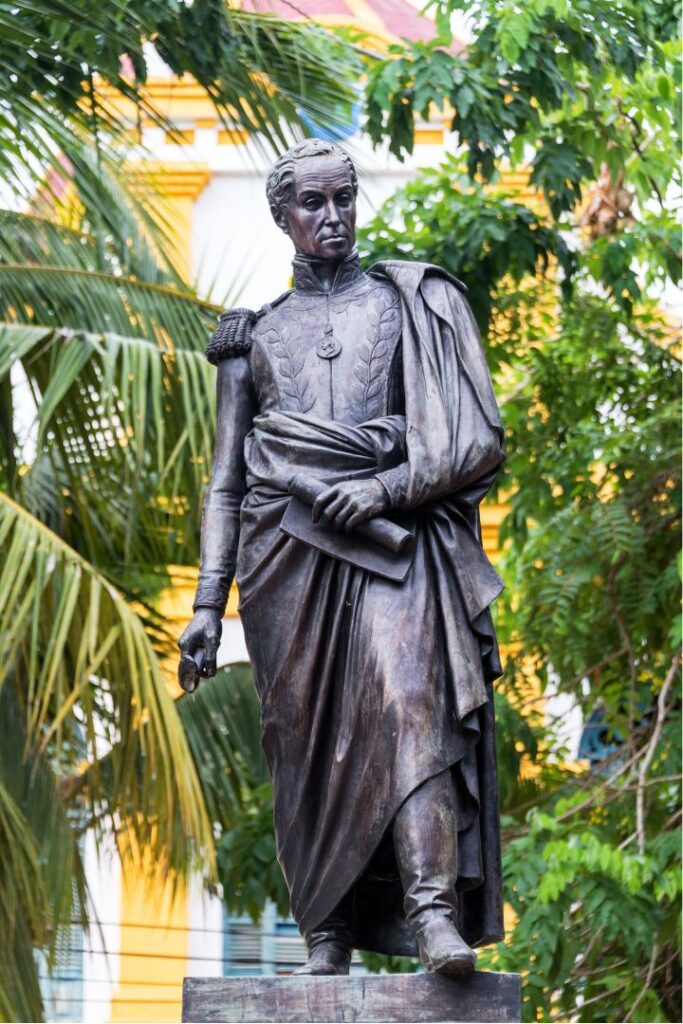
in Mompox, Colombia
La Gran Colombia was Comprised of Present Day Colombia, Ecuador, Panama and Venezuela
The newly named country comprised of Colombia (which at that time included Panama), Ecuador (which at the time was still partially still under Spanish rule) and Venezuela. La Gran Colombia was led by Francisco de Paula Santander, with its capital in Santa Fe de Bogotá, while Bolívar continued south to completely liberate Ecuador and Peru of any remaining Spanish Realistas.
La Gran Colombia Disbands After 11 Years
La Gran Colombia dissolved after 11 years partly because the territory was so large and communication between departments (states) was difficult. In addition, the local leaders and oligarchy were dissatisfied with the approved constitution and the election of Bogotá as the capital. Between November 23 and 25, 1829, in Caracas and Valencia Venezuela, a convention took place to decide what form of government the republic should have. The members of this assembly concluded that the definitive separation of the government from Bogotá was in Venezuela’s best interest thereby ignoring the authority of Bolívar.
Ecuador Follows Venezuela’s Lead and Frees Itself from La Gran Colombia
After learning of Venezuela’s separation from Colombia, Quito also decided to separate. On May 13, 1830, an assembly of notables met in Quito in order to resolve the separation of their region from La Gran Colombia. The Southern District declared its independence from Colombia, forming the nation of Ecuador.
Panama, with Backing of the United States, Separates from La Gran Colombia
The United States interests in the Panama Isthmus including the rights to construct and control the Panama Canal project led to an American intervention and military deployment in Panama (then part of Colombia). Colombia had previously rejected an offer from the United States to build the canal. José Agustín Arango Remón, a Panamanian politician and lawyer, that supported the separatist movement from Colombia, collaborated with the United States. The separation of Panama from La Gran Colombia occurred on November 3, 1903. This event occurred at the end of the Thousand Days War.
Colombian Food
In Colombia, any type of celebration, event or other social gathering is usually accompanied with a typical dish. It’s a very diverse country that grows many different types of vegetables, fruits and legumes. Some type of meat or seafood are typically used.
Colombian Food Stems from Various Cultures
The Colombian gastronomy is the result of a fusion of food and traditions of the Indo-American, Spanish and African cultures. Each region has a typical dish with their own ingredients and method of preparation. Some that stand out are the Ajiaco Santafereño, Arepa, Bandeja Paisa, Empanada, Lechona Tolimense, Mamona o Ternera a la Llanera, Mote de Queso, Mute Santanereano, Sancocho, Tamal, and various types off fish in the coastal areas.
Cosmetic Surgery and Medial Tourism in Colombia

Colombian Women Like Cosmetic Surgery
Colombia has become a prime destination for inexpensive cosmetic surgery. Cosmetic surgery is very common in Colombia and not only for the wealthy. Colombia ranks seventh in the world for number of cosmetic surgery procedures. Cosmetic surgeries are performed in major cities of Colombia with Cali having the most clinics.
Over Half a Million Cosmetic Surgeries Performed Per Year
According to International Society for Aesthetic Plastic Surgery, in 2017, Colombia had an estimated 1,000 registered surgeons. That same year 542,070 cosmetic surgeries were performed in three categories. The three categories are: Face and Head, Breast, and Body & Extremities.
Over 300,000 Non-surgical Procedures Reported Each Year
Non-surgical procedures are also broken down into three categories: Injectables, Facial Rejuvenation and Other. There were 323,980 non-surgical procedures performed in 2017. These numbers only include registered surgeons and procedures. One should do a great deal of research on any clinic before consenting to any procedure.
Major Cities to Live in Colombia
Bogotá, Colombia

Bogotá is the district capital of the Republic of Colombia. Located high in the Andes Mountains at an average altitude of 2,640 meters (8,661 feet) above sea level, it is the third-highest capital in South America after La Paz, Bolivia and Quito, Ecuador and it is the fourth highest capital in the world behind Thimphu, Bhutan. Bogotá is also the third largest capital city in terms of population in South America after São Paulo, Brazil and Lima, Peru. The Colombian capital is made up of 20 localities called comunas and is the administrative, artistic, cultural, economic, industrial, political, sports and touristic center of the country. Bogotá has a population of 7,150,000 (2017). The city receives around two million visitors each year.
Climate in Bogotá, Colombia
The climate in this city is moderately cool, its average temperature is 14 ° C (57 ° F). The dry season is from January to the end of February and from July through the end of August. The intense rainy season occurs from March through May and from September through November. Sometimes very strong storms or downpours occur, which may be accompanied by hail.
GaWC Rates Bogotá “Alpha -“
In 2018, The Globalization and World Cities Research Network, commonly abbreviated to GaWC, a think tank that studies the relationships between world cities in the context of globalization, ranked Bogotá as Alpha-. Bogotá accompanied the following cities in this categorization to give one an idea of its global impact:
The Following Cities Were Ranked Alpha- by GaWC
Amsterdam, Barcelona, Bogotá, Brussels, Budapest, Dublin, Houston, Johannesburg, Lisbon, Luxembourg, Manila, Montreal, Munich, New Delhi, Prague, Riyadh, Rome, San Francisco, Santiago, Shenzhen, Stockholm, Vienna, Washington, D.C.
The Best Places to Live in Bogotá, Colombia
Due to the heavy traffic, most people living in Bogotá prefer to live in a place close to their work and thus avoid long commutes. The north, east and center of Bogotá offer the best housing options. These areas are chosen for their proximity to cafes, movie theaters, shopping centers, restaurants and universities. The areas such as Candelaria, Cedritos, Chicó, Galerías, and downtown Bogotá are good neighborhoods that are moderately priced. The areas such as La Cabrera, Rosales, Santa Ana, Seminario and Usaquén are more exclusive neighborhoods with higher prices.
Bogotá Improves Its Image with “Comunidad Segura” Initiative
Bogotá has made a huge effort to change its previously notorious image in the 1990’s as being one of the most violent cities. In 1993 there were 4,352 homicides at a rate of 81 for every 100,000 people. In 2007 there were 1,401 murders in Bogotá at a rate of 20 for each 100,000 residents, and 2017 saw an even further decrease to 14 for per 100,000 residents (the least since 1979). This achievement was possible due in large part to a security initiative called Comunidad Segura. It began in 1995 and continues to be enforced.
Strata Classification in Colombia
Colombia classifies its neighborhoods in zones called estrato. Estrato properly translates to strata or stratrum in English. One of its definitions is “A level or grade of a people or population especially with reference to social position and education.” For example, “The lowest stratum of society in Chicago is in the south.” In Colombia the strata are numbered on a scale of 1 to 6 with 1 being the poorest and/or most dangerous and 6 being the wealthiest and/or safest. For this reason, people in Bogotá, tend to feel most insecure in stratas 1 and 2 located in the southeast and center.
Traffic in Bogotá Colombia
Traffic in Bogotá is notorious and air pollution in the city is a serious issue just as in Medellin according to El Tiempo (Spanish). It has a traffic restriction program in place called Pico y Placa (Peak and Plate) to help somewhat alleviate the issue.
Pico y Placa
Pico y Placa was initially established in Bogotá in 1998 by Bogotá’s Mayor at the time, Enrique Peñalosa. The system restricts traffic access to pre-established urban area for vehicles with license plate numbers ending in certain digits on pre-established days and during certain hours. Initially the system in Bogota restricted traffic between 6 and 9 am, and between 5 and 8 pm, Monday through Friday. Visit Pico y Placa (Spanish) for more information.
Live Close to What’s Important to You
One should look for an area with decent access to the places that are important to them such as health clubs, hospitals, their job, parks, public transportation, schools, and shopping centers or at least supermarkets. The best areas to live are: Chapinero, Chicó, La Cabrera, Rosales, Salitre, Santa Bárbara and Sector 93.
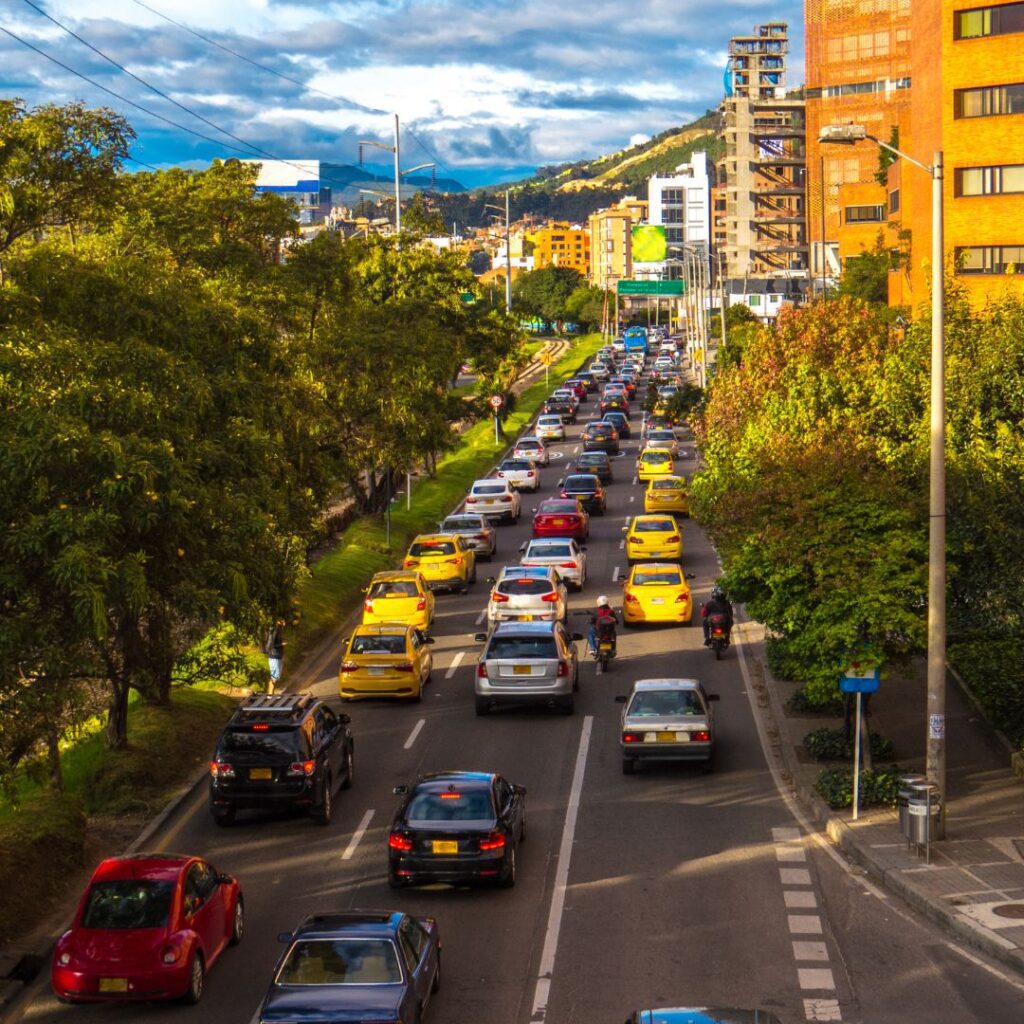
Cultural and Tourist Places in Bogotá, Colombia
Cerro Monserrate in Bogotá, Colombia
Cerro Monserrate is a symbol of Bogotá. It’s located in the eastern mountain range at 3,152 meters. At the top it houses the sanctuary of Señor Caídos de Monserrate surrounded by lush vegetation and from where you can see the best panoramic view of Bogotá. One can enter the hill in three ways: along the pedestrian, funicular and cable car path where you will surely have incredible views towards the city of Bogotá.
Neighborhood La Calendaría in Bogotá
La Calendaría is a neighborhood located in the center of Bogotá. La Calendaría is home to various monuments, squares, museums and historical buildings surrounded by streets where you can see surprising graffiti murals. La Calendaría is a neighborhood that combines the modern with the old and historical where one can learn about Colombian culture. The main attraction is the Plaza Bolívar, the Botero Museum, the Gabriel García Márquez Cultural Center, the Gold Museum, the Colón Bogotá Theater, among other buildings, galleries.
Villa de Leyva, Bocayá
Villa de Leyva is a town located in the Ricaurte province of the Boyacá department. Villa de Leyva is located 165 km from Bogotá about 2 hours away and is perfect for a weekend getaway. The Town of Villa Leyva represents a colonial architecture, the main square is the most outstanding icon of Villa Leyva. Another point of interest is the Terracotta House is a habitable house made entirely of mud and the Blue Wells are a total of six greenish blue water wells, the color is due to the strong concentrations of sulfur, selenium and copper sulfate.
Cartagena de Indias, Colombia
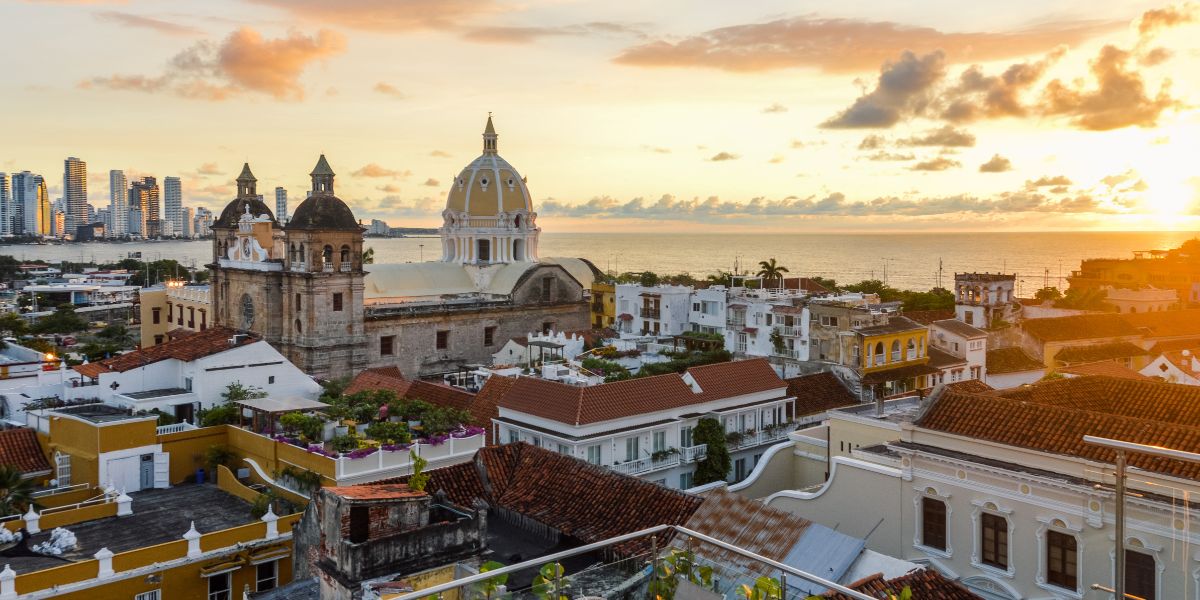
Cartagena de Indias, better known simply as Cartagena, is located in the north of Colombia on the shores of the Caribbean Sea. Cartagena is the capital of the Bolívar Department (State). The city was founded on June 1, 1533, and named after Cartagena, Spain. It has become one of the most important ports in Colombia and the world. Cartagena is the fifth largest city in the country with an estimated 1,036,412 residents.
Climate in Cartagena

Cartagena is Hot and Humid
Cartagena is located at sea level making it hot and humid. Humidity averages around 90%, with two rainy seasons typically from May through June, and October through November. It can be quite windy. Cartagena has an annual average temperature of 27.5 (°C) or 81.5 (°F). Due to its location Cartagena isn’t affected by hurricanes. It was extremely hot and humid when I visited.
The Walled City and Castillo San Felipe de Barajas are Popular Tourist Destinations
Cartagena is a famous tourist destination thanks to its famed Walled City, the San Felipe de Barajas fortress, natural attractions and rich history. It receives about 3 million visitors per year. Cartagena’s historic center known as the Walled City along with Castillo San Felipe de Barajas were declared a World Heritage Site in 1984 by UNESCO.
The Best Places to Live in Cartagena
If one likes a modern and urban vibe, then without doubt the northern area of Cartagena is the best. One can find numerous condos with modern architecture and a beautiful view of the Caribbean Sea. The downtown area is where one can find houses with a colonial architecture and a lot of history. If that’s one’s thing, then downtown is the place for them.
Become Familiar with the Different Strata Classifications in Cartagena
As mentioned previously Colombia classifies their neighborhoods in terms of estratos. The estratos are numbered on a scale of 1 to 6 with 1 being the poorest and/or most dangerous and 6 being the wealthiest and/or safest. In Cartagena, Bocagrande and the Walled City area range from estratos 4-6. Therefore, both of these areas are generally safe and well protected. The Colombian government and the majority of people in Cartagena have an ongoing interest in keeping Cartagena the booming tourist attraction that it is.
Use Common Sense Security Measures When Visiting Cartagena
Due to the massive amount of tourism, and low income of the local population there is a vast number of scams and petty theft in Cartagena. Travelers should use common sense security measures and maintain a low profile. Many Colombians live close to the poverty line and are trying to survive.
Common Sense Security Tips for Colombia (or Anywhere)
Use Common Sense Security Measures When Visiting Cartagena
Use the tips above. Put some nice fitting pants on. In most Latin and European countries people generally only wear shorts for the beach or working out. Don’t wander everywhere in shorts. It just makes one that much more of a target. Naturally, if someone is very white skinned and blue eyed, there’s not much they can do to “fit in” in Cartagena as its general population is simply darker skinned than Bogotá or Medellín. Don’t be afraid, but don’t exacerbate the issue either. Walk around with just enough cash as needed. Remember to always count your change. Get prices up front. Use Uber (when in a safe area to take out your phone) and take extra precaution at nighttime. Remember No dar papaya! Otherwise have an awesome time in Cartagena!
Beaches Near Cartagena
Cartagena proper doesn’t have very nice beaches despite being on the Caribbean Sea. Even the city’s “nicest” beaches in Bocagrande and Castillogrande are strewn with garbage and infamous for being crowded with extremely annoying walking vendors. The best beaches sit on nearby islands and or are much further away on the coast.
Playa Blanca on Isla Baru
One that is mentioned quite often as being very beautiful is Playa Blanca on Isla Baru. It is approximately 45 minutes away from Cartagena via speedboat. One can get there by car, but it will take a little more than an hour and upon arrival there are restrictions as to how far one can drive. Therefore, people wanting to drive will have to be ready to hoof it for about a mile. I’ve read that this “island” was once part of the mainland and therefore not considered part of the Rosario Island chain. The only real complaint about Playa Blanca is the overcrowding and the constant harassment by vendors. There are no luxury hotels just ecohotels with limited accommodations. Otherwise, it’s generally considered a gorgeous beach with beautiful turquoise water and golden sand that is not too far from the mainland. This makes it a good day trip for early risers to enjoy a full day and head back to mainland Cartagena in the late afternoon or early evening.
Playa Bonita on Isla Grande
Another popular yet further beach destination is Playa Bonita on Isla Grande. This is considered part of the Rosario Island chain and one can only get there by boat. A speed boat will get one there in about one hour. This island is less crowded than Isla Baru, most likely due to it being further away. It has a bit more to do and/or see than just the beach. Similar to Isla Baru there are no luxury hotels. The island features one of Pablo Escobar’s former abandoned estates. There is also a plane wreck in the sea not far from the estate which one can view by snorkeling.
Castillo San Felipe de Barajas
This fortress is a must see for anyone visiting Cartagena. It’s open to the Public. The Spanish tended to name most if not all their fortress’ as Castillos or Castles but make no mistake; this is not at all a castle where a prominent King and Queen would reside. This fortress is a beast.
The Castle is Imposing
Sitting at just 12.5 meters (41 feet) above sea level, it’s an extremely formidable military fortress overlooking the Caribbean Sea filled with baileys, curtain walls, tunnels and turrets used to house canons to fight invaders. The fortress is well preserved. As mentioned above, UNESCO listed the fortress along with the historic center of the city of Cartagena in 1984 as a World Heritage Site. It’s considered the greatest military fortress ever built by the Spanish empire.
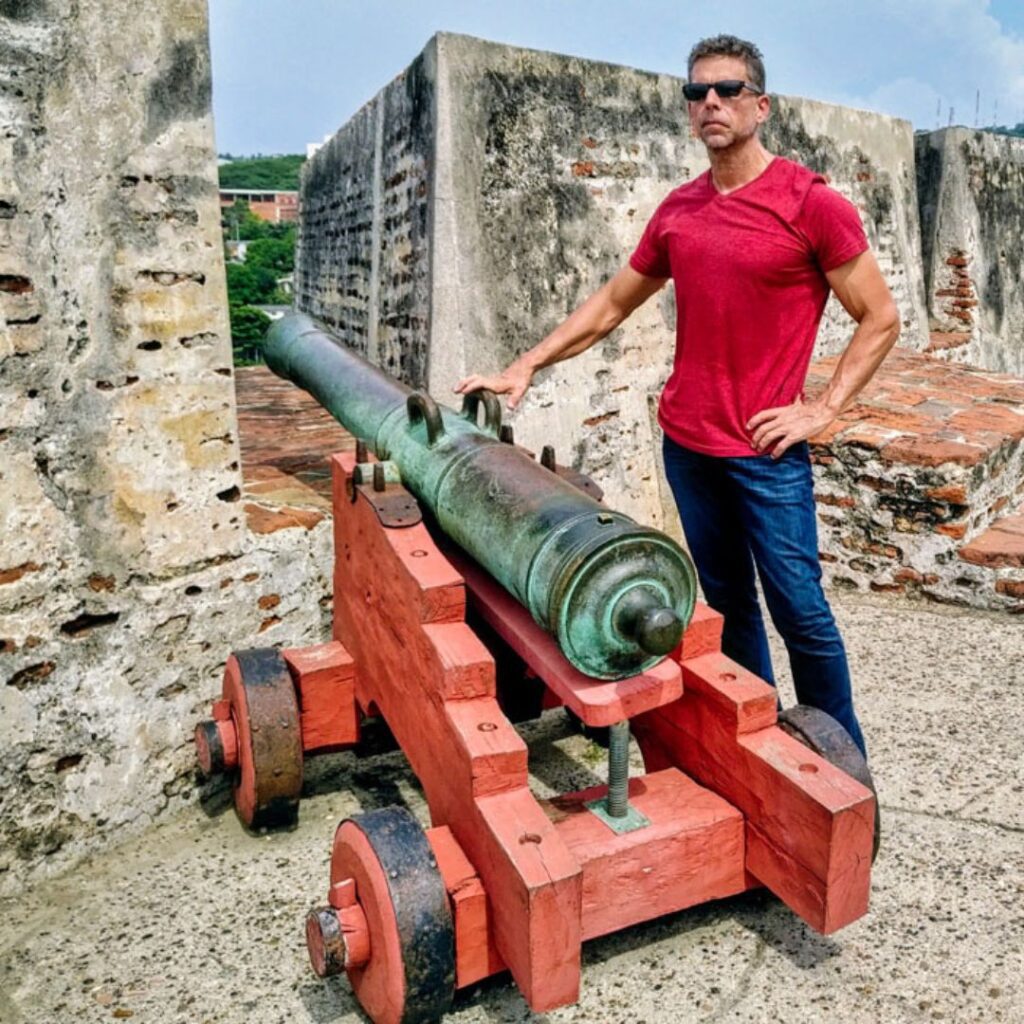
Cali, Colombia
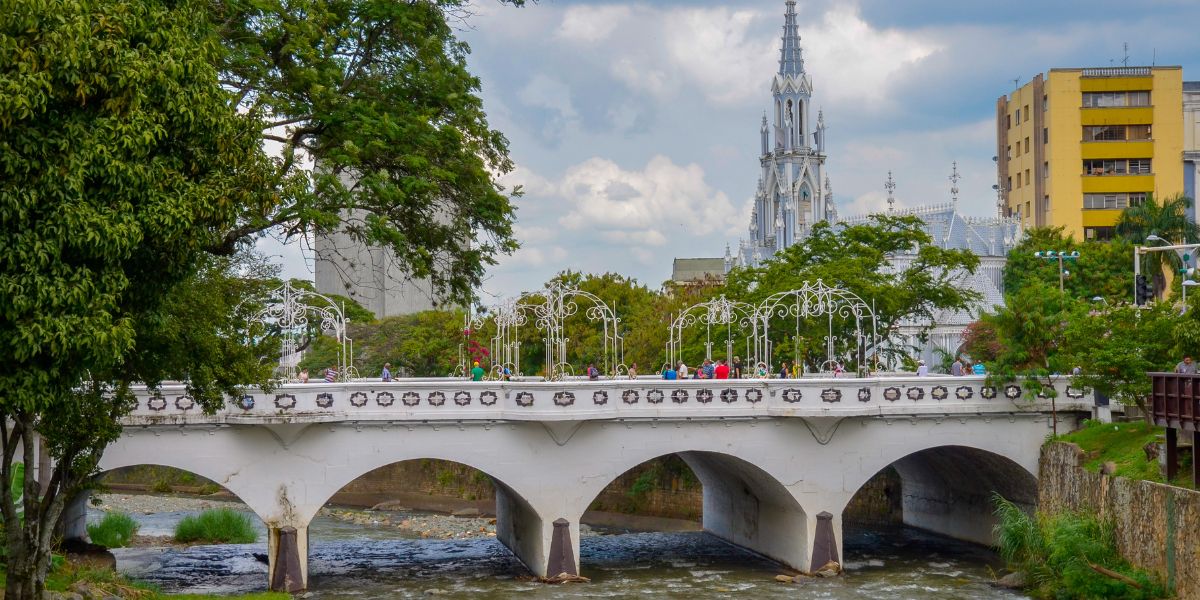
Cali was founded on July 25, 1536, by the Spanish explorer Sebastián de Belalcázar. Cali is the capital of the Department of Valle del Cauca and is the third most populous city in Colombia (Spanish). It’s located in the Cauca Valley, west of the Cauca River and east of the Cordillera Occidental, near the hills called Farallones de Cali. The city is located approximately 1,000 meters (3,281 feet) above sea level. Cali has an approximate population of 2,471,474.
Cali Receives UNESCO Designation
Cali has been chosen by UNESCO as one of the most creative cities of digital arts in the world (Spanish). It was ranked fourth in the Americas after Austin, Toronto and Guadalajara. Cali is the only city in South America with this recognition.
Climate in Cali
The climate of Cali is warm and dry. The average temperature is 24.0 ° C (73.6 ° F). Throughout the year the maximum temperature is 36 ° C (96 ° F) and the minimum is 13 ° C (55 ° F). The dry season is from December to February and from June to August. The rainy season is from March to May and from September to November.
The MIO Has an Extensive Bus Route
Masivo Integrado de Occidente (MIO) has a bus system that runs on devoted lanes in the middle of Cali’s important avenues, with stations adjacent to walkways by dedicated pedestrian crossings or overpasses. The routes encompass 243 kilometers (151 miles). The MIO was not only developed for public transportation but also incorporated large gardens, parks, public squares, and large sidewalks for people to enjoy.
Gondolas Are Part of the MIO System
Gondolas or cable cars are also part of the MIO system. It is called the MIO Cable. It is completely incorporated within the network and directly serves the inhabitants of the Siloé district.
The Best Places to Live in Cali
Western parts of Cali such as Avenida de los Cerros, Los Cristales, and Santa Teresita are considered nice, developing areas to live. Pance, located in comuna 22 is the most exclusive area located to the south of Cali. It has great views of nature and modern apartments and houses. Other areas such as El Peñón, San Antonio and San Cayetano are also attractive areas with that offer a great quality of life. Capri City is another area that has good urban development.
Cali’s Crime Rate Decreases in 2012, Surveillance Cameras Are Installed
In 2012 saw a decrease in homicides in Cali, with 24 cases less than 2011. There were 294 less individuals harmed, which means was a decrease of 8% from the previous year. There were 323 less vehicle car jackings, 21% fewer than in 2011., for example a lessening of 21% over a similar time of 2011. There were 152 less home break-ins; a decrease of 17% from 2011. Cali also invested in the installation of 254 surveillance cameras.
Cali Increased Its Budget to Fight Crime
Previous to 2012 the budget for Cali’s security was 4 times less than Medellin and 7 times less than Bogotá. Crime still remains an issue in Cali. Groups such as Los Rastrojos, considered the ‘heirs’ of the Cali Cartel, and Los Urabeños known for their presence on the Colombian coast have a grip on the narcotics industry. However, overall, the residents feel much safer than in years past. Petty crime is still prevalent throughout Colombia in general and Cali is no different in that regard. As mentioned for all the other cities No dar papaya!
Cali, the Capital of Salsa Dance and Music

Cali, La Capital de la Salsa
Cali is known as the Capital de la Salsa given the city’s adoration for that musical genre. Cali holds Summer Salsa Festival at the beginning of July which goes on for a week. It includes shows by some of the world’s best salsa musical and dance groups. It also involves melomano competitions in which salsa gurus attempt to outdo one another by delving profoundly into the chronicles of salsa music to discover old tunes.
“Delirio” Happens the Last Friday of Every Month
On any night of the week one can find little salsa clubs throughout Cali offering an assortment of Afro/Caribbean beats. The last Friday of each month, the city puts on a fabulous, internationally known event known as Delirio. Visitors to Cali are fascinated by the “Las Vegas” style production of these amazing shows.
Cali Tourist and Cultural Places
San Antonio neighborhood in Cali
The San Antonio neighborhood is located in the west of Cali and limits to the north with the El Peñón neighborhood. It is the most traditional neighborhood in Cali, preserving a colonial architecture. A symbol of the San Antonio neighborhood is the chapel that bears the same name, which is in the Baroque style with more than 250 years that is located at the highest point of the hill (Spanish). Because it is the most cultural neighborhood in Cali, one can get to know the various theaters and works, art galleries, schools, public libraries, and craft exhibitions. In addition, one can taste Colombian food and its delicious coffee in the variety of restaurants that exist in San Antonio.
Boulevard del Río or Boulevard of Avenida Colombia in Cali
It is a boulevard located on the banks of the Cali River near the city center. The Boulevard del Río is built on the longest urban tunnel in Colombia (Spanish) 980 meters (3,215 ft), through which the old Avenida Colombia now runs, has decongested the city’s traffic. It’s a cultural and recreational spot for locals and tourists visiting the city. Along the boulevard you can find various tourist sites such as the Iglesia de la Ermita, which is the most photographed monument in Cali, El Parque de los Poetas, El Gato del Río, El Puente de Ortiz and various shops that offer delicious coffee from Colombia and its food. Access to street vendors is restricted, so you can enjoy a quiet and safe walk.
Monument to Christ the King
The Cristo Rey is a symbolic site of the city of Cali. Cristo Rey is a 26-meter-high statue that is located in Cerro los Cristales, just southwest of Cali. From the Cristo Rey monument, one can take in the nice view it has towards the city of Cali. It’s a very popular place for locals and foreigners alike.
Getaway to Guadalajara de Buga
Guadalajara de Buga or also known only as Buga, is a municipality located in the center of Valle del Cauca. Located 66 kilometers (41 miles) approximately one hour from the city of Cali. Buga is part of the Red de Pueblos Patrimonio de Colombia. One can enjoy the beautiful historical center of Buga, observing the colonial architecture of the buildings. An example of this is the Minor Basilica of the Lord of Miracles which is the fourth oldest in Colombia. Buga is considered a faith destination with around 2 million pilgrims visiting Buga each year. It is considered the origin of the spiritual route of the Americas.
Medellín

Medellín is Located in the Aburrá Valley on the central mountain range of the Andes. Medellin is the capital of the department of Antioquia. It is the second most populated city in the country. On March 1, 2013, The Wall Street Journal and Citigroup Inc. (NYSE: C) announced Medellín as the winner of ‘City of the Year’ in its worldwide competition launched in 2012. The program was developed in partnership with The Urban Land Institute and sponsored by Citi to recognize the most innovative urban centers. More than 980,000 online votes were cast during the program with 200 cities in consideration. Medellín edged out Tel Aviv and New York. The city has a population of 2,508, 452 inhabitants (2017).
Medellín is Divided into 16 “Comunas”
The urban sectors of the city are divided into 6 zones, and these in turn are divided into communes or comunas totaling 16. Just to be clear, all neighborhoods are a comuna.
Comunas Are Not Defined as Slums
Some people mistakenly believe that a comuna is defined as a favela or slum. Not so. Even the wealthiest neighborhood in Medellín, Colombia, El Poblado, is a comuna. It is located in Comuna 14. Another popular well known, somewhat upper-class neighborhood, which many prefer over El Poblado for its Colombian authenticity is Laureles or technically Laureles-Estadio which is part of Comuna 11.

Climate in Medellín
Due to its location between the mountains in the Aburrá Valley, Medellín enjoys a pleasant climate. Medellín is known as the City of Eternal Spring. It has a monsoon subtropical climate, according to Wikipedia. Because Medellín is located at 1,500 meters (4,900 feet) above sea level, it’s not as hot as other cities located at the same latitude near the equator. The city’s average annual temperature is 22 °C (72 °F). Due to its proximity to the equator, its temperature is constant year-round, with minimal temperature variations.
Traffic in Medellín
Medellín is notorious for its bad traffic. It utilizes the same Pico y Placa (Spanish) driving restrictions similar to Bogotá to help somewhat alleviate the issue, although the hours may differ slightly.
Transportation Systems in Medellín
Medellín has a vast public transportation system including diesel buses, taxis, trams and an urban train referred as the Medellin Metro, the only metro system in Colombia. Medellín even has cable cars or gondolas that were built in 2004 that traverse parts of the city from high above. Additionally, well run, clean, and functioning outdoor escalators located in a poor neighborhood that was previously considered the most dangerous neighborhood in Medellín known as Comuna 13 were installed in 2011 at a cost of around 5 million dollars. Now it’s a tourist destination believe it or not. The cable cars and escalators make it easier for the residents to get up and down the hillsides. These innovations have dramatically helped decrease the violence and install more hope within the community. Uber is also operational in Colombia and quite popular.
Air Pollution in Medellín
Air pollution is a serious issue in Medellín due to the fact it sits in the Aburrá Valley and contaminants tend to linger in the valley until sufficient wind blows it up and away. There is an ongoing effort to find and implement solutions to the issue of air pollution in Medellin including the signing of the Clean Air Pact or Pacto por el Aire (Spanish). One example of the initiative is introducing new electric buses and taxis and eventually phase out gasoline versions of such vehicles.
The Best Places to Live in Medellín
Medellín is has become a hot spot for digital nomads, expats and tourists in addition to Colombians. Quite simply, Medellín has a lot going for it. Medellin has excellent clinics, hospitals, gyms, modern public transportation infrastructure and beautiful shopping centers. Medellín has tremendous internet speeds and technology overall. The best areas to live in Medellín are: Belén, El Poblado, Envigado, La Candelaria (Center), Laureles, Parque Lleras along with Via Provenza, and Sabaneta to name a few.

El Poblado or Laureles?
El Poblado and Laureles typically take the top 2 spots in most people’s opinion.
El Poblado
El Poblado is the wealthiest area and popular with tourists and wealthy Colombians alike. One downside for many is that it is quite hilly. This makes it difficult to walk around for some people and also hard to drive if one has a car or motorcycle with a manual shift.
Laureles
Laureles, on the other hand, is not quite as “high-end” as El Poblado, nevertheless it’s a nice flat area that one can walk around easily. Many people “in the know” actually prefer Laureles as it’s a more authentic Colombian lifestyle as opposed to the more Americanized Poblado. There’s no right or wrong place to choose. It just depends on one’s preferences. The aforementioned neighborhoods are generally considered safe. There’s a surprisingly vast number of green spaces in Medellín. Some really nice parks are spread throughout the city.
Violence Remains an Issue in Medellín
Violence is an issue that has diminished considerably in Medellin over the past 30 years or so although a recent uptick has occurred. According to Wikipedia, “By 2015, the homicide rate has fallen to 20 per 100,000 people, the lowest rate in decades.” However, “By 2019, the homicide rate had risen to 24.75 per 100,000 people.” “Generally, crime rates increase the further the neighborhood is from the center.” More affluent areas such as El Poblado and Laureles seem to be less affected although petty theft is always a concern as is the case in almost any developing nation. Remember No dar papaya!
Medellín as a Tourist Attraction
Medellín has transformed itself into a tourist attraction despite being once the most feared city on the planet. Each year Medellín receives almost one million foreign visitors, and the numbers keep growing. Besides regular vacations from foreigners that embrace its natural beauty, it is a medical tourism hotspot (including plastic surgery for which it’s well known).
Medellín and Narco Tourism
Narco tourism has sprung up in recent years. Yes, people are quite interested in seeing Pablo Escobar’s grave which ironically sits in the same cemetery only a few yards from Griselda Blanco’s aka La Madrina, the Black Widow, the Cocaine Godmother and the Queen of Narco Trafficking.
Pablo Escobar’s “Prison” La Catedral
Narco tourists venture out to see Pablo Escobar’s “prison” that he had built for himself called La Catedral which is now a nursing home for seniors, and the infamous nondescript building where he was shot and killed on the red barrel tiled rooftop on December 2, 1993, a day after his 44th birthday. That building, that lies between 2 streets, is now a Spanish school on one side and a real estate business on the other.

Pablo Escobar’s Hacienda Nápoles
Another destination is Pablo Escobar’s former home, Hacienda Nápoles, which was a glorious estate in Puerto Triunfo, Antioquia, approximately 150 kilometres (93 miles) east of Medellín and 249 kilometres (155 miles) northwest of Bogotá. The estate covers about 20 square kilometres (7.7 square miles) of land. It has been turned into a safari style theme park.
Is Narco Tourism Immoral?
The residents of Medellín seem to be divided as to the morality of narco tourism. Many Colombians make a living off it, and many appreciate the money the tourists bring in. Others recall Escobar’s Robin Hood like generosity of building churches, homes, hospitals, schools, and soccer fields. He had houses built for the poor and gave out cash resulting in his nickname “Robin Hood Paisa”.
Medellín Demolishes Pablo Escobar’s Monaco Building
Other Colombians, rightfully so, believe it is wrong to praise and or profit off a murderous drug tyrant, responsible for killing an estimated 4 to 5 thousand people, and destroying the lives of many Colombians and their families. The former Mayor of Medellín (January 1, 2016 -January 1, 2020), Federico Gutierrez, shares this belief and on February 22, 2019, had the white, concrete, six-floor apartment building known as the Monaco demolished; a place that Escobar and his family once called home.
Pablo Escobar and His Family Once Survived a Bombing at the Monaco Building that Left His Daughter Manuela Escobar Henao n/k/a Juana Manuela Marroquín Santos Partially Deaf
The Escobar family once survived a bombing at the Monaco building on January 13, 1988, by the rival Cali cartel that killed 3 people. The explosion severely damaged the building and the Monaco sat idle for nearly 30 years. Cesar Augusto Zapata, an engineer who worked on the construction of the 9/11 memorial in New York is in charge of building a memorial to honor the victims of narcoterrorism associated with Escobar’s cartel in Medellín. The explosion left his daughter, Manuela partially deaf in one ear.
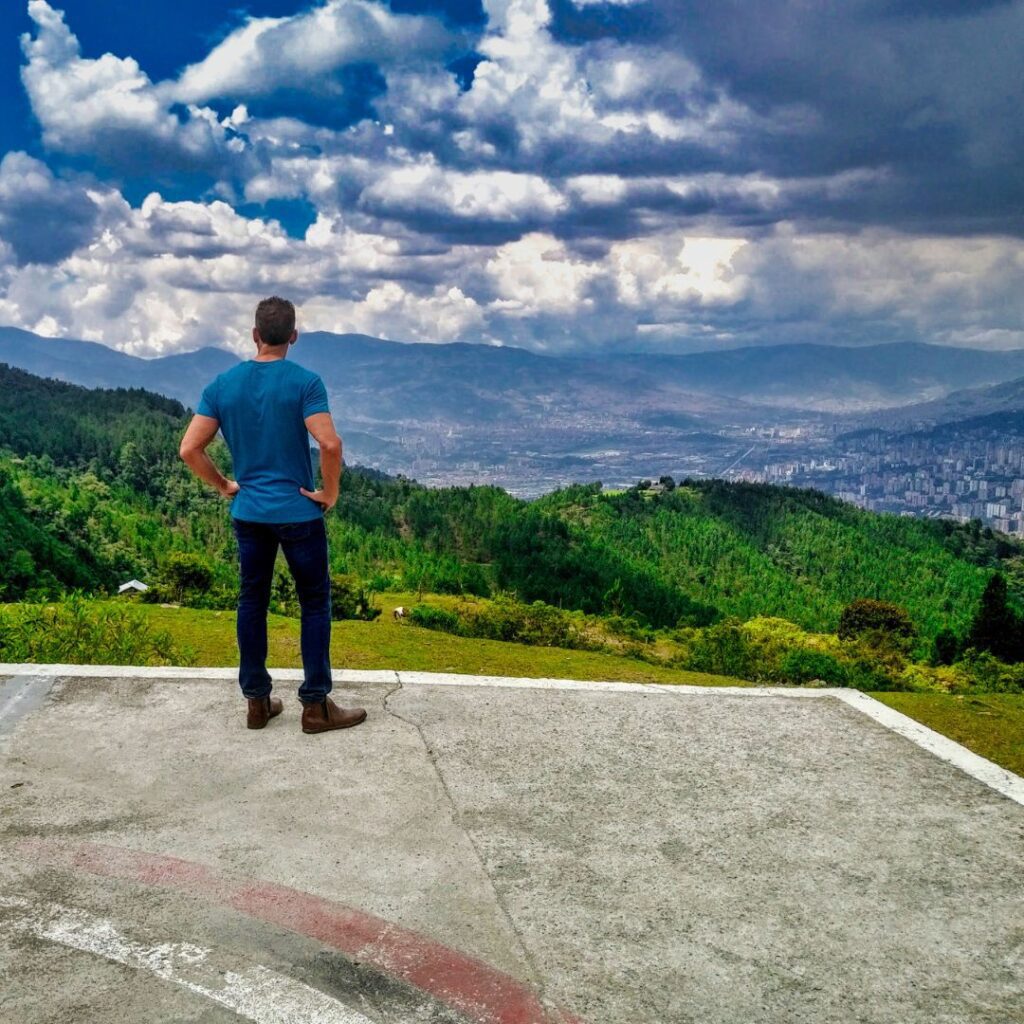
Avianca Flight Number 203, The Straw that Broke the Camel’s Back
Esbobar’s failed attempt at killing 1990 presidential candidate, César Augusto Gaviria Trujillo, by blowing up Avianca flight number 203 was the last straw for many.
November 27, 1989
On the morning of November 27, 1989, the Avianca jetliner was on route from Bogotá to Cali, at 7:13 AM. 13 minutes later an explosion killed 110 innocent people (all 101 passengers, 6 crew members, and 3 on the ground). It was the tipping point for many including the United States, as 2 U.S. citizens were among the dead. The Bush administration initiated the Intelligence Support Activity operations to find Escobar.
President-elect César Gaviria Never Boarded the Plane
President-elect Gaviria didn’t board the plane and later became the President of Colombia in the 1990 elections. Drug dealers killing other drug dealers is one thing but blowing up a plane and murdering 110 innocent people is another.
Guatapé, Antioquia
When visiting Medellín, make sure to take the time to visit Guatapé. Guatapé is a municipality in Colombia, located in the western part of the department (state) of Antioquia. It’s located 75 kilometers (46.6 miles) from Medellin. Guatapé’s cobblestone streets are adorned with multi-colored houses. Two story structures abound with nice, wooden balconies.

The Walk Up El Peñon is No Joke!
El Peñón de Guatapé aka La Piedra del Peñol
One of Antioquia’s most popular tourist attractions is El Peñón de Guatapé, also known as La Piedra del Peñol. It’s a 220-meter-high monolith located between the municipalities of Guatapé and El Peñol. El Peñón de Guatapé has 702 steps to the top. There’s an additional small tower staircase at the top to take you a bit further above the base of the summit with vendors inside. It’s a natural wonder with panoramic views of the 2,000-hectare reservoir that consists of several islands in shades of green surrounded by calm waters.
Other Notable Cities or Towns in Colombia
Barranquilla is located on the western shore of the Magdalena River that flows into the Caribbean Sea. It’s the fourth most populous city in Colombia. Barranquilla is the main economic center of the Caribbean Region of Colombia. Barranquilla is known for its footwear and fishing industries. Barranquilla receives the most tourists during carnival season which is between February and March of each year.
Bucaramanga is the capital of the department of Santander, located to the northeast of the country on the Eastern range of the Andes Mountains, on the banks of the Gold River. Bucaramanga is known for its agriculture and footwear industry. Pararagliding at the “Voladero de las Águilas” is a popular activity. The Cerro del Santísimo and the Chicamocha National Park are a couple of scenic tourist attractions. The Chicamocha National Park can be reached via cable car.
Cúcuta is the capital of the department of Norte de Santander. It is located in northeastern Colombia in the eastern Andes. Cúcuta is a border city with Venezuela located 12 kilometers from San Antonio del Táchira and at the moment is quite chaotic due to the diaspora in Venezuela with a massive flow of immigrants that enter Cúcuta daily. However, for those who enjoy helping those in need, visiting Cúcuta could be a tremendous and moving experience, even if it is only temporary.
Colombian Coffee Axis includes cities such as Armenia, Ibagué, Manizales and Pereira, located in the Central and Western Andes Mountains. The Colombian Coffee Axis has a great climate, beautiful landscapes and is one of the most visited areas of Colombia.
Visas in Colombia
Tourists can stay in Colombia for up to 90 days. Tourists can request a visa extension in Colombia (Spanish) that is granted for an additional 90 days. This request can only be made once per calendar year. If one wishes to live temporarily or permanently in Colombia, they must apply for the appropriate visa.
Colombia Reduces Its Visas to Three
In December 2015, Colombia reduced their 21 visas to only 3: Visitor (type V), Migrant (type M) and Resident (type R). For visas in Colombia, consult the Foreign Ministry of Colombia. Here are the most common visas:
Driver’s Licenses and Importation of Vehicles for Foreigners in Colombia
Your Driver’s License from Your Home Country Is Fine
As a tourist one can drive with their valid driver’s license from their home country during their stay. If one intends on staying more than 6 months with a temporary or permanent residency visa they should apply for a Colombian driver’s license.
Permanent Importation of Used Cars Isn’t Allowed
In Colombia one can import his car temporarily as a tourist (Spanish). Colombia doesn’t allow for the permanent importation of used cars. One may import new cars although the tariffs charged are most likely not worth the hassle. However, there are some exceptions with cars that are considered “classic” or “antiques”. Diplomats may be allowed to import vehicles, through their country’s embassy.
Properties in Colombia
Foreigners can buy properties in Colombia with a current passport and sufficient funds. One should consider hiring counsel with regards to the purchase and sale contract and requirements necessary for a valid transfer of property in Colombia. Also, if interested one may obtain a residency visa from the purchase of real estate if the sales price is equivalent or greater than the current requirements of the R Visa.
Get the True Market Value in Colombia and Don’t Overpay
Foreigners should be aware of real market prices, since sellers usually inflate prices to non-Colombians otherwise known as the Gringo Tax. A potential buyer should check comparables just as they would in their own country. However, these comparables should be listed in local Spanish only newspapers or websites. Not all, but most English only websites selling property in Colombia, or anywhere for that matter, are geared toward expats that don’t have knowledge of the local language or market. Many of these English only sites try and sell properties at inflated prices to the naïve foreigner. Don’t let that happen. Be smart!
Money Used to Buy Property is Registered through Banco de la República
The money with which one buys the property must be registered and nationalized through Banco de la República. To register foreign direct investment, one must fill out the form Declaración de Cambio por Inversiones Internacionales (Spanish) and provide it to the bank.
Know Your Expenses When Buying Property in Colombia
Make Sure Property and Valuation Taxes are Paid
The buyer should make sure the current owner has paid property and valuation taxes. There are three (3) documents in particular needed for a secure transfer. One is the Paz y Salvo Predial which shows proof the property taxes have been paid. The second is the Paz y Salvo de Valorización which proves any taxes due on the increased value of the property have been paid. These two documents can be obtained at the Instituto de Desarrollo Urbano (Spanish). Thirdly, the Certificado de Tradición y Libertad is needed. This document is granted by the Superintendencia de Notariado y Registro (Spanish) and contains necessary information about the property in the last 20 years such as:
Hire a Notary Public to Ensure the Deed “La Escritura” is Free of Encumbrances
One can acquire the aforementioned documents in person or via internet. The registration number of the property or the address must be supplied. At this point a notary public must be hired to check that the title to the deed called la escritura is clear of any encumbrances and will sign the purchase and sale agreement along with the buyer and seller assuming that no issues arise during the due diligence process. The last step is to sign la escritura with the notary public and have it recorded. La escritura is a written legal instrument confirming the new legal owner of the property.
Transaction Costs for Purchasing a Home in Colombia
Property Tax in Colombia
Property taxes are due at the municipal level, where the property is located. Anyone who owns a property is obliged to pay it annually. The amount of the property tax due is set by the appraised value set by the municipal’s appraisers office or cadastral and multiplied by a certain percentage set by the mayor’s office. The rate ranges between 0.3% and 3.3% of the appraisal of the property.
Pay Property Taxes in Colombia
Income Taxes in Colombia
Taxes are charged based on resident status in Colombia. According to article 10 of the tax statute, people who stay in Colombia for 183 days or more per year based on date of entry are liable to pay income tax on any money earned in Colombia and the rest of the world. For dual citizens, Colombia has taxation treaties with other countries in order to avoid double taxation.
The DIAN establishes the Unit of Tax Value or UVT
Each year The DIAN (Spanish) establishes the UVT (Unit of Tax Value), for the taxable year. The UVT for 2022 is $38,004 COP. The rate set for the following taxable year is published at the end of each year (Spanish). The UVT is determined by the variation of the Consumer Price Index (CPI) for the country’s middle class between October 1 of each year. For example, for 2022 the UVT is calculated by taking the variation in the CPI for the period between October 1, 2020, and October 1, 2021.
All Taxpayers Must have a RUT Assigned
In order to comply and pay one’s taxes a RUT (Unique Tax Registry) number is required. An appointment can be made at the local DIAN in order to have a RUT number assigned. Taxes may be paid online through the DIAN website (Spanish).
Income Taxes on Corporations in Colombia
Income tax, Impuesto a la renta y complementarios, must be paid by all local and foreign corporations operating in Colombia. Corporations are subject to a tax of 25%.
Cost of Living in Colombia
Basic services and food in Colombia are typically low cost. Numbeo is a site where one can compare costs of food and services with other cities around the world. Keep in mind that Numbeo data is user generated which could skew the numbers should someone choose to enter a ridiculous amount either on purpose or by accident. Also, smaller cities or towns may not have enough user generated data entered and therefore not be available or viable for comparison. Still, it’s a good place to check out to compare cost of living statistics for decent sized cities. Another similar site to check cost of living around the world is Expatisan.
Salaries in Colombia
| Minimum Wage | Money Earned | Hours Worked |
|---|---|---|
| Minimum Monthly Salary | $1,160,000 COP ($273.72 USD) | Full Time Salaried Employee |
| Monthly Transport Subsidy | $140,606 COP ($33.18 USD) | Full Time Salaried Employee |
| Minimum Daily Wage | $38,667 COP ($9.12 USD) | Ordinary day |
| Minimum Hourly Salary | $4,833 COP ($1.14 USD) | During hours from 6 am to 9 pm |
Banking in Colombia
Colombian banks are quite strict with foreigners due to concerns of money laundering, pressures from the US surrounding FACTA and to further themselves from their tumultuous past in the late 1980’s and 90’s. Unfortunately, a tourist cannot open a bank account. One must have a visa and an immigration card which is issued for all foreigners over 18 who hold a visa for more than 3 months.
Permission to Carry Firearms in Colombia
In Colombia there are two types of permits to carry firearms, national and regional. In order to grant a permit for the acquisition of a weapon (Spanish), a committee from The Ministry of Defense will evaluate one’s request. Background checks are required for both the regional permit Judicial Police and Investigation Section (SIJIN in Spanish) and the national permit Directorate of Criminal Investigation and INTERPOL (DIJIN in Spanish).
Latam Living Page List
Latam Living Post List
Moving Abroad? Congratulations! 5 Essential Things to Consider!
Moving Abroad? Congratulations! 5 Essential Things to Consider! Moving Abroad? Have You Considered What’s Truly…
Crazy! Mérida Record Temperature of 43.7 ºC (110.66ºF) 🥵
Crazy! Mérida Record Temperature Reaches 43.7 ºC (110.66ºF) On March 26th, 2024, Mérida Record Temperature…
9 Pros of Living in Mérida, Yucatán
9 Pros of Living in Mérida, Yucatán Here are 9 Pros of Living in Mérida,…
Mérida is Overhyped?
64 Million Hispanics and Latinos in the United States
64 Million Hispanics and Latinos in the United States Hispanics and Latinos Don’t Mean the…

